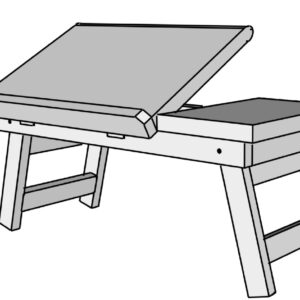Will pine wood warp if used for a short tabletop?
Hi,
We are planning to make 13 portable laptop-like tables for a community project. To keep cost down we plan to use pine wood. The tabletop will be approximately 42″ long and 12″ wide. The tabletop will be hinged on one side so it can be raised and lowered. The tables will only be used inside. My question is it likely for the tabletop warp over time? Please let me know if there are alternatives if warping is highly likely.
We are basing our design on a template from This Old House. I uploaded a picture from their website. In our design, the entire table will raise. There won’t be a fixed portion.
Below are the descriptions from Menards of the wood we are considering.
Option 1:
1 x 12 x 4′ Select Pine Board
Kiln dried for stability
Surfaced Four Sides (S4S)
Radiata Pine species
Clear, C & Better Grade where appearance is paramount
Option 2:
Mastercraft® 1 x 12 x 4′ Edge Glued Board
Kiln dried for stability
Surfaced Four Sides (S4S)
Species vary between Spruce & Pine
Knotty B-Grade and sanded for a nicer finish
Edge glued to create a solid board
Net thickness may vary between 5/8″ and 3/4″
For interior use only
Thanks,
Deen















Replies
eastern white pine is a very stable wood, when dried properly(check with a moisture meter) if you purchase the lumber at the big box store, let it sit in your shop for at least a month before you machine it to dimension.that is assuming you have a relative humidity at around 30% all the time.
I wouldn't touch Mastercraft glued up crap. In a 12" x 48" board you might have 60 small pieces of wood glued together to make that "board."
I'd use eastern white pine, from a lumberyard, not a big box store. I get mine at a local mill. It's clear, knot free, and costs half what the big stores charge.
If you are keeping all 4 feet as a single hinged lid, add some battens to help it stay flat. But at that length you are likely to get some twist over time.
A 12 inch wide board of solid pine is almost certain to cup over time unless, as John C2 suggested, you add some batons to help it stay flat. If you do use batons, attach them with screws to allow seasonal movement of the table top. Do not use glue.
Rather than using a single 12-inch wide piece of pine, I'd suggest you search for one made of long, narrower boards that are edge-glued together. It will be much more stable. Typically, such boards are available in home centres as shelving.
Thank you all for the quick responses.
If we stay with this design, would 3 battens going be sufficient - a batten at each end and one the middle?
Someone had suggested pine, but we are open to other wood species that are not too costly and are durable. (The desk will be used by kids.)
Would we face the same issue with this type of plywood? Again from Menards …
3/4 x 4 x 8 B2 Maple Wood Veneer Core Plywood
B2 grade
Rotary Cut
Veneer core
Thick sandable face and back
Would the wood still cup if we removed the hinges and fixed the tabletop to a 1x2 frame?
I found one lumber mill in the area so I’ll go by there this weekend.
Thanks!
Is stair tread resistant to cupping?
Home Depot
EVERMARK
Stair Parts 48 in. x 11-1/2 in. x 1 in. Unfinished Pine Plain Cut Engineered Stair Tread
Wood moves. The sooner we accept that fact, the easier our life becomes. That said, there are things you can do to minimize the end result of wood movement on your project. Buying quality kiln dried wood helps, a large part of the moisture has been removed already. Wood tends to move more in the last few % of moisture content, so allowing it to acclimate to an environment similar to its future home will also help. Battens will help mitigate the forces of movement. I have used the premium pine (radiata) material from Menards that you mention, and in general I really like it. That said, it still moves/cups a noticeable amount once it's been in my garage for a few weeks. I notice it more in the wider stuff, like the 1x12. Individual grain and grain orientation of each piece effects what kind of movement you can expect. In general, construction lumber (ie. stair tread) is much wetter than the premium pine. I would not choose this unless you plan to let it dry for a much longer period of time, and expect to do a decent amount of work get it flat. Kiln dried is drier still than the premium pine. If you choose plywood you won't need to worry nearly as much about wood movement. It should be minimal, but sometimes it can still happen with thinner plywoods.
Honestly, if this is a project for kids, I would probably use whatever is clear of knots, straightest grain of the bunch, and let is acclimate for a week or two in a decently similar environment before banging out the projects. When the wood moves, it should still be useable, depending on your design/tolerances. Once the tables have been used for a term, you should be able to see what type of movement actually happens and what could be improved.